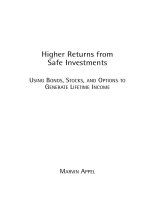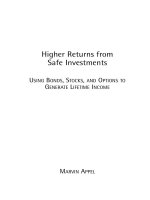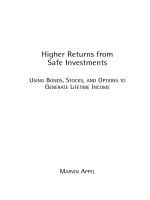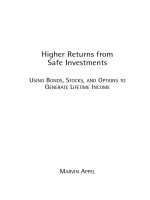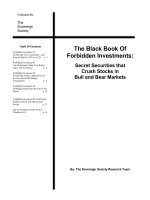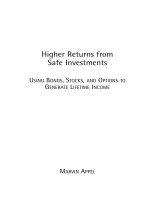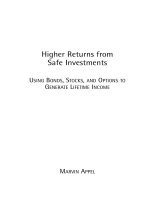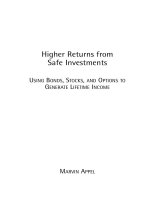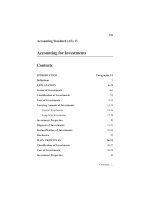Victorian investments
Bạn đang xem bản rút gọn của tài liệu. Xem và tải ngay bản đầy đủ của tài liệu tại đây (2.34 MB, 261 trang )
Investments
Edited by
Nancy Henry and
Cannon Schmitt
bleed area
x
Victorian
New Perspectives
on Finance and
Culture
Victorian Investments
Victorian
Investments
New Perspectives
on Finance and
Culture
edited by
nancy
henry
&
cannon
schmitt
Indiana University Press
Bloomington and Indianapolis
This book is a publication of
Indiana University Press
601 North Morton Street
Bloomington, IN 47404-3797 USA
Telephone orders 800-842-6796
Fax orders 812-855-7931
Orders by e-mail
© 2009 by Victorian Studies and Indiana University Press
All rights reserved
No part of this book may be reproduced or utilized in any form or
by any means, electronic or mechanical, including photocopying
and recording, or by any information storage and retrieval system,
without permission in writing from the publisher. The Association
of American University Presses’ Resolution on Permissions
constitutes the only exception to this prohibition.
The paper used in this publication meets the minimum
requirements of American National Standard for Information
Sciences—Permanence of Paper for Printed Library Materials,
ANSI Z39.48-1984.
Manufactured in the United States of America
Library of Congress Cataloging-in-Publication Data
Victorian investments : new perspectives on finance and culture /
edited by Nancy Henry and Cannon Schmitt.
p. cm.
Includes bibliographical references and index.
ISBN 978-0-253-22027-1 (pbk. : alk. paper) 1. Investments—
Great Britain—History—19th century. 2. Finance—Social
aspects—Great Britain—History—19th century. 3. Finance in
literature. I. Henry, Nancy, date II. Schmitt, Cannon.
HG5432.V53 2008
332.60941′09034—dc22
2008017202
1 2 3 4 5 14 13 12 11 10 09
To Tom and Dana
Contents
Introduction: Finance, Capital, Culture 1
Nancy Henry and Cannon Schmitt
PART 1. A Prehistory of Victorian Investment
1. “Signum Rememorativum, Demonstrativum, Prognostikon”:
Finance Capital, the Atlantic, and Slavery 15
Ian Baucom
PART 2. Cultures of Investment
2. Writing about Finance in Victorian England: Disclosure and
Secrecy in the Culture of Investment 39
Mary Poovey
3. The First Fund Managers: Life Insurance Bonuses in
Victorian Britain 58
Timothy Alborn
4. Limited Liability, Market Democracy, and the Social
Organization of Production in Mid-Nineteenth-Century
Britain 79
Donna Loftus
5. Fair Enterprise or Extravagant Speculation: Investment,
Speculation, and Gambling in Victorian England 98
David C. Itzkowitz
6. Ladies of the Ticker: Women, Investment, and Fraud in
England and America, 1850–1930 120
George Robb
PART 3. Fictions of Investment
7. Trollope in the Stock Market: Irrational Exuberance and The
Prime Minister 143
Audrey Jaffe
8. “Rushing into Eternity”: Suicide and Finance in Victorian
Fiction 161
Nancy Henry
9. Rumor, Shares, and Novelistic Form: Joseph Conrad’s
Nostromo 182
Cannon Schmitt
Afterword
202
Martin Daunton
Bibliography
221
List of Contributors 241
Index
243
viii Contents
Victorian Investments
Introduction
Finance, Capital, Culture
Nancy Henry and Cannon Schmitt
The temptation is to begin with a contemporary reference—and there are so
many to choose from. In Every Man a Speculator: A History of Wall Street in
American Life (2005), for instance, Steve Fraser quantifies the late twentiethcentury surge in investment by noting that “[m]ore was invested in institutional funds between 1991 and 1994 than in all the years since 1939. And the
biggest share of that capital was deposited in pension plans” (583). Or, more anecdotally, in a memoir about the bursting of the dot-com bubble titled American Sucker (2004), David Denby observes that by the end of the 1990s, “[i]nvestment had become as much a part of popular culture as baseball, fishing,
and bar-hopping” and “pension funds and 401(k) plans had turned factory
workers and even university intellectuals into investors” (24). Such a beginning
would do double duty. It would not only indicate our sense that the rising tide
of scholarly interest in investment in other places and times derives at least in
part from investment’s new visibility in this place and time, North America and
Europe at the start of the twenty-first century; it would also convey the consensus among our contributors that a signal moment in the genealogy of the
economic world we now inhabit is to be found in nineteenth-century Britain.
The developments in investing that transformed Victorian society—including
the proliferation of global markets, the passage of laws establishing limited
liability, and the creation of new knowledge disseminated through financial
journalism—established a reality that now seems familiar to us, one in which
participation in equities markets is (relatively) democratized, the stock exchange serves as the economic pulse of many nations, and investing itself takes
on the status of a ubiquitous preoccupation encouraging hopes of financial security even as it forces difficult moral and social as well as economic questions.
If such assertions about novelty, origins, and continuity are demonstrably
valid, however, they are also dangerous. For they not only give short shrift to the
long and vibrant history of scholarship on the Victorian economy, investment
included; they also risk eliding the historical, cultural, and textual specificity to
which the contributors to Victorian Investments: New Perspectives on Finance
and Culture are committed. Nonetheless, there has certainly been a recent intensification of attention to all facets of the Victorian culture of investment
among academics who are witnessing if not actively participating in our own
intensified culture of investment. In the special issue of Victorian Studies published in 2002 that stands at this book’s own origins, we and our co-editor,
Anjali Arondekar, argued that the articles we had gathered together showed a
commonality of intent that “begins to define a field” (Schmitt, Henry, and
Arondekar 9). Since then, a host of new studies has appeared in that field on
topics ranging from the identities of investors in the East India Company and
the extent and significance of investing by women to the centrality of speculation in the plots of Victorian novels and plays. This focus on what Victorians
chose to do with—and how they chose to write about—their unprecedented excess capital forms part of a broader historical interest in analyzing the role Victorian financial instruments and institutions played in the daily lives of Britons
across a remarkably wide spectrum of society.
Expanding on the journal issue with which it shares a title, Victorian Investments brings together work by historians and literary and cultural critics that
illuminates and interrogates the place of finance capital not only in the Victorian period but also in scholarly approaches to that period. Perhaps the most
notable aspect of the latter is the degree to which most of our contributors
concentrate less on a critique of Victorian capitalism per se than on overlooked
dimensions of the culture of investment such as the rise of financial journalism,
the centrality of insurance, changes in the liability laws, the mingling of investing and gambling vocabularies, and the overlap of financial with romantic or
sentimental plots in Victorian literature. This marks a change from past scholarship; the difficulty, however, lies in how best to characterize it. Reviewing a
set of books on the economic aspects of Victorian literature that proceed in
the absence of what he sees as a Marxist-inspired condemnation of capitalism,
Jonathan Rose has asserted: “We are now witnessing the emergence of something quite unprecedented—a capitalist criticism” (489). We cannot embrace
such a tag, in part because a number of our contributors make the inequities
and inhumanity of the system they examine central to their analyses, but like
Rose we do recognize the emergence of an approach to the Victorian economy at
once more wide-ranging and more fine-grained than those versions of Marxist
critique focused on industrialism have fostered. In this regard and others Victorian Investments constitutes a break. But, of course, such a departure would
have been impossible were the collection not also responding to recent scholarship in the field—and so it is to the ways our contributors both build upon and
contest that scholarship that we turn for the remainder of our introduction.
The History of Finance as the History
of Society and Culture
Were it possible to identify a single overarching axiom among historians of the Victorian economy over the last twenty years, it would have to
involve the inextricability of business and finance from the rest of Victorian
society—from class, race, and gender; religion, law, and politics; and literary as
well as other artistic and cultural production. Now-classic works such as Boyd
2 Introduction
Hilton’s The Age of Atonement: The Influence of Evangelicalism on Social and
Economic Thought, 1785–1865 (1988), assessing the role of evangelical Christianity in how economics was understood and practiced, and Leonore Davidoff
and Catherine Hall’s Family Fortunes: Men and Women of the English Middle
Class, 1780–1850 (1987), looking at the impact of financial organizations and
opportunities on middle-class families, paved the way for later investigations
that begin with the assumption that finance intersected forcefully with other
aspects of life in nineteenth-century Britain. Historical studies such as George
Robb’s White-Collar Crime in Modern England: Financial Fraud and Business
Morality, 1845–1929 (1992), Thomas L. Haskell and Richard F. Teichgraber’s
collection The Culture of the Market: Historical Essays (1993), Timothy Alborn’s Conceiving Companies: Joint-Stock Politics in Victorian England (1998),
and Margot Finn’s The Character of Credit: Personal Debt in English Culture,
1740–1914 (2003), to name a few, parlayed that understanding into expansive,
inclusive, and innovative accounts of Victorian business and finance. Literary
scholars and critics, too, have turned their attention to how Victorian literature
was affected by and reflected on dramatic financial change. Studies such as John
Vernon’s Money and Fiction: Literary Realism in the Nineteenth and Early Twentieth Centuries (1984), Barbara Weiss’s The Hell of the English: Bankruptcy and
the Victorian Novel (1986), and Norman Russell’s The Novelist and Mammon:
Literary Responses to the World of Commerce in the Nineteenth Century (1986)
have been followed by ever more probing investigations of the imbrications of
the financial and the literary, including Paul Delany’s Literature, Money and
the Market: From Trollope to Amis (2002), the essays in Andrew Smith’s special issue of Victorian Review on “Literature and Money” (2005), and Francis
O’Gorman’s collection Victorian Literature and Finance (2007).
This work is characterized above all by an intense interdisciplinarity, with
historians drawing frequently on the literary realm, literary and cultural critics
taking care to situate their analyses in specific historical contexts, and both historians and critics attending closely to economic history in particular. The essays collected here also feature this trademark—as it were—disciplinary crossfertilization. Historians George Robb, Timothy Alborn, David Itzkowitz, and
Donna Loftus make literature central to their arguments, while critics Ian Baucom, Mary Poovey, Audrey Jaffe, Nancy Henry, and Cannon Schmitt place their
readings of literary and visual texts in direct relation to the state of “the financial system in nineteenth-century Britain” (to borrow a phrase from the title of
Poovey’s influential collection on financial writing). Another sort of inter- or
transdisciplinarity is in evidence as well: many of these essays demonstrate the
potential for bringing philosophy and literary and cultural theory to bear on
the history of finance, seeking to explain the complexities of investment’s place
in culture (and culture’s place in the system in which investment loomed so
large) by way of Immanuel Kant, Jacques Derrida, Fredric Jameson, and Gérard
Genette, among others. Furthermore, several contributions enable us to see
the transatlantic and indeed global implications of Victorian Britain’s culture
of investment: the long shadow of the slave trade (Baucom); the comparative
Nancy Henry and Cannon Schmitt 3
progress of women’s rights in the United States and Britain (Robb); the influence of Victorian financial plots on American novelists (Henry); and the imperialist contours of British and U.S. investment in Latin America (Schmitt).
On one hand, these essays may be distinguished from other scholarship engaging Victorian writing on political economy and economic theory such as
the contributions to Martha Woodmansee and Mark Osteen’s collection The
New Economic Criticism: Studies at the Intersection of Literature and Economics
(1999), Regenia Gagnier’s The Insatiability of Human Wants: Economics and
Aesthetics in Market Society (2000), and Catherine Gallagher’s The Body Economic: Life, Death, and Sensation in Political Economy and the Victorian Novel
(2006) by their empirical interest in Victorian finance capital. On the other, they
differ from more narrow histories of business, finance, or economics in their
insistence that the history of business and finance, and especially of investment
practices, is also the history of culture and cultural change. The contributors
do not, that is, speak of a “business culture”—how business is done—so much
as of the ways in which developments within the realms of business and finance shaped the everyday lives of Victorian Britons: the kinds of knowledge to
which they had access, the economic opportunities open or closed to them, and
their involvement in the everyday lives of the inhabitants of other parts of the
globe. To take only one example: widows, children, single women, and the elderly were becoming increasingly dependent on the Funds (national debt promising a fixed return), annuities, and shares in joint-stock companies. An entire
service sector grew up to cater to this growing class of investor—and among the
consequences were a new professional class (including financial journalists and
what Alborn calls “the first fund managers”), new forms of social protocol (in
response to puzzling questions such as how much businesses should disclose
about their operations or whether women should vote at shareholder meetings),
and new plots for fiction (in the novels of authors ranging from Charlotte Riddell and Arthur Conan Doyle to Anthony Trollope, George Eliot, Joseph Conrad, and Edith Wharton).
Insurance, Investment, and Empire
Work on the Victorian culture of investment has displayed an interest
both in statistical trends in investing over the course of the nineteenth century
and in the identities of the ordinary investors behind companies and enterprises. Nowhere, perhaps, have the two sides of that interest resulted in such
thoroughgoing rethinking of received wisdom than in the case of work on investors’ role in the expansion of the British Empire. In Mammon and the Pursuit of Empire: The Political Economy of British Imperialism, 1860–1912 (1986),
a monumental instance of sustained statistical analysis, Lance E. Davis and
Robert A. Huttenback sought to document the “direction and volume of portfolio finance that passed through the London capital market between 1865 and
1914” in the service of, among other things, settling the still-controversial ques-
4 Introduction
tion of whether empire was on the whole profitable for Britons (1). The answer
they provide achieves something of a compromise: elites, in their estimation,
did profit, while for the middle class empire was generally a losing concern financially. In British Imperialism: Innovation and Expansion 1688–1914 (1993),
P. J. Cain and A. G. Hopkins similarly focus on the economics of imperialism.
Whereas Davis and Huttenback largely follow established verities about what
the British Empire was, however, Cain and Hopkins prosecute a sweeping revisionist argument: namely, that what they call “gentlemanly capitalism”—“a
means of generating income flows in ways that were compatible with the high
ideals of honour and duty”—underwrote imperial expansion not only in the
nineteenth century but before and after as well (1: 46). Such capitalism is represented in the main by activities falling within the so-called service sector,
including insurance, banking, and investment. The somewhat startling claim
that follows is that British imperialism was not centrally about the acquisition
of territory. Cain and Hopkins see such acquisition as merely the occasional byproduct of what they argue was the essence of imperial expansion: the extension of the British service sector over ever-greater areas of the globe.
Animated, like British Imperialism, by the conviction that metropolitan and
imperial economies were intimately linked in the eighteenth and nineteenth
centuries, H. V. Bowen’s The Business of Empire: The East India Company and
Imperial Britain, 1756–1833 (2006) poses what at first seems to be a disarmingly modest question about “how the acquisition and expansion of an empire
in India affected the development of the East India Company in Britain” (ix).
But proposing an answer involves Bowen in the larger project of assessing the
complex influences of the East India Company itself on British society in general and shareholders in particular. He seeks to establish “why [shareholders in
the East India Company] held stock, how they acted, and how their group compositions altered over time” (84). Less driven than either Mammon and the Pursuit of Empire or British Imperialism by an argumentative thesis, The Business of
Empire puts its faith in the empirical, presenting a heretofore unknown wealth
of data about one group of investors. If on one hand those data promise future
revelations, on the other they foreground a question central to the work of Cain
and Hopkins: to what extent are data hostage to the interpretive assumptions
brought to bear on them?
In his contribution to this volume, which we consider an indispensable sort
of prehistory of Victorian investment, Ian Baucom takes up that question by
considering what might be thought of as the elided other half of Bowen’s object of inquiry, detailing not who investors were but what “goods” they invested
in. We have placed quotation marks around “goods” because in this case that
“what” is also a “who”: slaves aboard the Zong en route from Africa to markets
in the Americas. Facing a shortage of drinking water on board, the Zong’s captain and crew, invoking a clause in the ship’s insurance contract that allowed
some cargo to be jettisoned if it meant saving the rest, forced 133 slaves into the
sea. All but one drowned. Baucom offers a philosophical and historical medita-
Nancy Henry and Cannon Schmitt 5
tion that insists we view as persons this sacrificed “cargo.” Taking the incident
and its aftermath as a defining event of modernity, he provides a point of departure for the emergence of the money culture that this volume seeks to define
and understand. But, surprisingly, it is not the ethically revolting practice of
treating humans as so much insurable property that constitutes the Zong massacre as an event for Baucom. It is, rather, what such treatment reveals about insurance per se: that “a money culture cannot exist without insurance,” and further that the “genius of insurance, and the secret of its contribution to finance
capitalism, is its insistence that the real test of something’s value comes not at
the moment it is made or exchanged but at the moment it is lost or destroyed”
(30). The spectral but quite real effects of the money form that is finance capital
are made possible by that capital’s detachment from the specific properties of
the things in which it speculates—and by the guarantee against loss that insurance, with its prospective-retrospective valuation achieved precisely and only
from the vantage of loss, provides.
Timothy Alborn takes up the spectacular rather than the spectral side of
insurance in his chapter on Victorian life insurance bonuses. Examining all
aspects of those occasions on which life insurance companies’ surpluses were
either added to the value of policyholders’ policies or paid out directly to shareholders, from the actuarial to the theatrical, Alborn argues for the importance
of declarations of such bonuses in “attracting attention to investment as a social practice” and “publiciz[ing] money’s reproductive powers” (59). Here, too,
there is an engagement with the question of what it means to insure a human
life—not least in Alborn’s documentation of the efforts made in the eighteenth
and nineteenth centuries to establish who might be considered to have a legitimate financial interest in the life insured. But the focus is elsewhere, on how the
deliberate cultivation of suspense around the dispersion of surpluses affected
individuals and how insurance companies learned the value of marketing and
structuring their dividend and bonus payouts to appeal to a diverse company
of investors.
“Without insurance,” Baucom writes, “there is no finance capital” (29). One
need not uncritically agree with Cain and Hopkins’s redefinition of empire to
endorse the corollary dictum that without finance capital there is no modern
imperialism as we know it. Joseph Conrad, among others, understood as much.
Conrad’s Nostromo (1904) reveals Britain’s tentacular extension of its financial
sector into ever more remote parts of the non-European world to be, as Cannon
Schmitt writes in his contribution to this volume, “a kind of imperialism that,
however different from classic imperialist expansion in its workings, is similar
in its results” (188). Schmitt goes on to argue that Conrad’s novel is not simply
an indictment of informal imperialism but a harrowing examination of some
of the consequences of the culture of investment, consequences that follow
from a world in which value accrues or dissipates in response to the aleatory
force of rumor. But Conrad in this regard cannot do without the system he excoriates, for he enlists rumor to bring pressure on the form of the novel that, be-
6 Introduction
ginning with works such as Nostromo, broke down realist conventions through
the formal experimentation we call modernism.
The Role of the Working Classes and
Women as Investors
Although the expansion of Victorian financial markets into Britain’s
formal and informal empires and the diversification of investment opportunities at home contributed to what we have described as a relative democratization of the stock market, Conrad insists on the limits encoded in the word
“relative.” Nostromo depicts finance capital as the concern of male European
elites, signaling that, like other forms of democratization—particularly the extension of the franchise—the prospect of empowering women, the working
classes, or non-Europeans to become investors was controversial. In her contribution, Donna Loftus explores the debates surrounding the Limited Liability
Act of 1855 to show that the apparent laissez-faire ideal of turning everyone
into an investor was not considered an unqualified good: “Despite its potential
for the promotion of market democracy, limited liability confirmed the separate interests of capital and labor” (80). Exactly who would benefit from limited
liability was bound up with questions about the value and efficacy of political
and educational reform as well as with broader issues of communal identity.
Would limited liability help working men by allowing them to increase their
capital via investment? Or, as John Stuart Mill believed, would its benefits accrue to them only indirectly by increasing the wealth of capitalists who might
in turn lend money to the poor? The likelihood of the former made limited
liability a liberal cause epitomizing the potential of the market. At the same
time, the debate about liability encompassed “the role of the state in relation to
working men” and proved to be “an issue of knowledge of, and authority over,
prices and profits in local communities” (83, 93). Hovering somewhere between
a right and a privilege, investment, like voting, had to be exercised responsibly
(even in the absence of individual liability), and responsibility itself was understood to depend on the possibility or impossibility of education: “Reform,”
notes Loftus, “was about instructing the working classes in the intricacies of
the market and skills associated with capital” (87).
In showing the class implications of this aspect of financial history, Loftus
points out that the terms of the debate were also gendered in that they focused
exclusively on working men: “The debates around limited liability provided a
platform for one of the most wide-ranging public discourses of the relationship
between (male) labor and capital” (97). In contrast to controversies over political reform and male suffrage, there was never much public debate about
the right of women to invest their money in the stock market. Perhaps as a
consequence, there was never any barrier to single women doing as they pleased
with their money, and never any blanket prohibition on women participating
in the government of joint stock companies in which they held shares. The
Nancy Henry and Cannon Schmitt 7
right of married women to invest was of course inseparable from larger political debates about their property rights that raged throughout the nineteenth
century, but in terms of pure gender discrimination, the stock market seems to
have offered a uniquely egalitarian opportunity for women who had the means
to participate.
Pioneering archival work by Janette Rutterford and Josephine Maltby has
revealed the unexpected presence of women investors in the nineteenth century in all forms of public and private companies and so started the critical
conversation about the social significance of this presence. In “ ‘She Possessed
Her Own Fortune’: Women Investors from the Late Nineteenth Century to the
Early Twentieth Century” (2006), for example, they consider previously unasked questions about the extent and nature of women’s shareholding. In doing
so they show that, in contrast to married women (at least before the Married
Women’s Property Acts of 1870 and 1882), spinsters and widows held shares
with the same rights as men and, whether they exercised their rights or not,
were allowed to vote in shareholder meetings long before they were granted
the political franchise in stages following World War I (see also Rutterford and
Maltby, “The Widow”).
In a special issue of Accounting, Business and Financial History devoted to
“Women and Investment” (2006), Rutterford and Maltby gather both broad
surveys of women’s roles as investors and case studies from British and colonial
(Australian) contexts. One essay in that volume, “ ‘A Doe in the City’: Women
Shareholders in Eighteenth- and Early Nineteenth-Century Britain,” by Mark
Freeman, Robin Pearson, and James Taylor, offers the broadest published survey
of company records and quantitative data on women shareholders in joint-stock
companies, showing fluctuations in the number of female shareholders and the
percentages of shares held. These numbers demonstrate that there were more
women in the capital market than previously thought: “Women’s investment
in the corporate economy though not deep was extensive” (287). Further, Freeman, Pearson, and Taylor’s analysis reveals that women were involved in corporate governance and identifies an increasingly positive attitude toward women
shareholders beginning in the mid-nineteenth century, tracing this acceptance
to historical practices by which “stock companies placed female proprietors, if
often only by default, on largely the same constitutional footing as men” (288).
In his essay in Victorian Investments, George Robb adds to the growing body
of knowledge about women investors by examining both British and American
women’s financial activities. While acknowledging important differences between the two national investment cultures, he argues that the similarities are
important as well, and that the research need not remain segregated. Robb interrogates the stereotype implied in such phrases as “a doe in the city,” emphasizing that “while the corporate economy welcomed capital investments from
women, it offered them little protection from unscrupulous promoters” (120).
Weighing the benefits and dangers of investing to women and examining the
rhetoric of victimization and empowerment connected with female investors,
he finds that women were often prey to frauds and scams and “dependent on
8 Introduction
the riskiest and most vulnerable kind of economic activity: ‘gambling’ on the
stock market” (126). But public discourse about these dangers, Robb contends,
was exaggerated, and that exaggeration served a purpose: the female victim was
frequently invoked in literature and in the press “to marginalize women’s role
in the economy” (137). By the same token, however, and following the trend
of the contemporary women’s movement generally, by the Edwardian period
women’s vulnerability to financial victimization became a central tenet of British and American feminism. Despite cultural prejudices that encouraged passive investment through male mediators and threatened active women investors
by associating them with transgressive, unfeminine behavior or exposing them
to the designs of swindlers, as “the century progressed and as some middleclass women longed to escape the Doll’s House,” Robb concludes, “they came to
see economic empowerment and financial regulation as key to their liberation”
(139–40).
Robb joins Rutterford and Maltby, Freeman, Pearson, Taylor, and other historians in the project of giving us a much clearer picture of just how involved
women were in managing their money, adding to the chorus of voices now revisiting and complicating both the separate spheres ideology and assumptions
of female disempowerment in the nineteenth century. Significantly, he makes
fiction central to his discussion of cultural stereotypes of women investors, invoking a range of nineteenth-century authors from Trollope to Catherine Gore,
Mrs. Henry Wood, and Charlotte Riddell. While historians have looked to literature in support of their contentions about cultural attitudes to certain kinds
of investors and investment activities, literary critics have in turn suggested that
the investment activities of authors deserve heightened scrutiny. In George Eliot
and the British Empire (2002), for instance, Nancy Henry documents George
Eliot’s extensive colonial holdings and speculates on the degree to which knowledge of those holdings forces us to regard aspects of her fiction in a new light.
Similarly, Gail Turley Houston, in From Dickens to Dracula: Gothic, Economics, and Victorian Fiction (2005), examines Charlotte Brontë’s investments in
connection with her novels to illustrate how familiarity with the financial system manifests itself in the deployment of Gothic tropes. Among other things,
what Henry and Houston reveal is a curious bifurcation: while writers such
as Elizabeth Gaskell and George Eliot produced fiction in which bank failures
that cost women money and status figure centrally (see Miss Matty in Cranford, Gwendolen and her family in Daniel Deronda), the authors themselves
were responsible, educated investors who took advantage of the stock market
to supplement their incomes. Perhaps, as Robb might contend, the notion of
women as victims of the market proved more powerful—more literarily useful
or compelling—than these authors’ own experience of market success.
Form and Finance
To note that Victorian novelists found failed investment an alluring plot
device is of necessity to make a point about form. And although such a point
Nancy Henry and Cannon Schmitt 9
might appear to be of narrowly literary interest, a number of the contributors to this volume suggest that attention to form—in connection with institutions and subjectivity no less than the novel—is required of any meaningful
analysis of the new culture of investment in nineteenth-century Britain. This
should come as no surprise. It was, after all, Marxism that kept attention to
form alive during those not-too-distant dark ages when formalism was a methodology that dared not speak its name, and did so precisely by insisting on the
economic “base” or mode of production itself as a form or structure. Fredric
Jameson’s Marxism and Form (1972) details the twentieth-century history of
this tradition, which may be said to reach its apogee in Jameson’s own The
Political Unconscious (1981). Thus, as Baucom observes, when he refers to the
“ever more exhaustive, ever more total, ever more complex, ever more ubiquitous and (because ever more ubiquitous) ever more unremarkable penetration
of the Heideggerian life-world by the cultural logic of finance capital,” his mode
of thinking is recognizably “Jamesonian” (32). This is in large part because his
reflections on insurance and money culture—as may also be said of Schmitt’s
contentions about rumor, investment, and modernism—are enabled by the
proposition that finance capital entails a specifically cultural logic.
In her contribution, Mary Poovey takes a different approach to explaining
the relationship between finance and form. Tracking the emergence of a new
kind of “financial writing,” she shows how it functioned to “normalize or
naturalize the workings of financial institutions” (45). At the center of that
writing, and of the culture of investment out of which it grew, she locates a
kind of double bind—at once contradictory and constitutive—between the
imperative to disclose as much information as possible and the necessity of
keeping some information secret. Having demonstrated the presence of this
relationship between disclosure and secrecy in financial writing and institutions, Poovey turns to George Eliot’s The Mill on the Floss. What in financial
writing itself works to naturalize the financial system, in a novel provides the
opportunity for its defamiliarization: The Mill on the Floss and other realist
novels “enabled readers to experience imaginatively the dynamic by which
Britain’s financial institutions generated monetary value and to reflect upon
the affect this dynamic created” (55). In this sense, formal features of the novel
including the shape of its plot recreate the pervasive structure of disclosure
and secrecy, but with the effect of rendering it visible and, therefore, subject
to critique. “Having experienced this [structure] in an arena in which they
might reflect upon it,” Poovey writes, “readers might even have been encouraged to wonder if the dynamic of disclosure and secrecy that financial journalism sought to normalize was quite as natural as journalists wanted it to
seem” (55).
One of Poovey’s key contentions is that The Mill on the Floss features two
distinct plotlines, financial and sentimental, and that by novel’s end the latter overwrites and displaces the former. For Audrey Jaffe, however, reading
Anthony Trollope’s The Prime Minister, no such distinction exists: “The marriage plot is, in fact, the financial plot: the lesson Emily Wharton learns about
10 Introduction
Lopez is taught by way of her increasing knowledge of his financial dealings”
(148). Further, in contrast to Poovey’s reading of Victorian realist novels as
potentially affording critical distance on the culture of investment, Jaffe emphasizes the degree to which their disruptive or defamiliarizing effects are recontained. “After the narrative of Lopez’s exuberance, of Emily’s mistake, and
of the degradation that results from their entanglement,” she writes, “comes
the embrace of what might now have to be called rational exuberance: the ordinary emotions of the married, middle-class subject, whose choice, shaped
by life’s hard lessons, is articulated by that narrative as a choice of investment
over speculation” (157). The disagreement here, although routed through works
by George Eliot and Trollope, is not about differences in individual Victorians’
view of the system in which they found themselves enmeshed but inheres in
divergent estimations as to the function of realist fiction—and, by extension,
aesthetic production as such—vis-à-vis the economic realm.
Investment, Speculation, or Gambling?
The distinction Jaffe perceives in The Prime Minister between investment and speculation, as well as the novel’s representation of speculation as a
game and a form of irresponsible gambling, underwrote moral concerns about
the nature and state of the stock exchange and the City throughout the nineteenth century. Most of the contributors address or at least mention this fundamental problem of definition, which emerged repeatedly in financial writing:
was there really any difference between investing and speculating and, furthermore, were speculators nothing more than glorified gamblers?
Writing about the appearance of “bucket-shop keepers” who served a growing number of working-class investors and advertised themselves in ways similar to sporting bookmakers, David Itzkowitz shows that many feared that they
were “turning the world of financial speculation into a new form of popular
entertainment whose morality was ambiguous at best” (99). His essay explores
that anxiety as it was reawakened in the 1870s, when the bucket-shop brokers
challenged the uneasy legal acceptance of the distinction between speculating and gambling that had allowed speculation to flourish in an increasingly
free market even while gambling was outlawed. Such anxiety, which Itzkowitz
argues never totally disappeared, was “at least partially responsible for the continued existence of the discourse that equated speculation and gambling” (118).
Scrutinizing the lines between investing, speculating, and gambling, lines that
fluctuated continually in legal, financial, and popular writing throughout the
Victorian period, Itzkowitz reveals one constant: the function of the specter of
“gambling” in maintaining speculation’s legitimacy.
To return to the pages of realist fiction after this foray into the world of
bucket shops and bookmakers is to perceive the legal, political, and terminological disputes around gambling and speculation carried on via characterology. Several contributors consider the way cultural fears about the market
are displaced onto that mid- to late Victorian novelistic mainstay, the disrepuNancy Henry and Cannon Schmitt 11
table and dangerous stockbroker or financier. Both the thrill and the danger of
speculating attached to this ubiquitous figure, who is often explicitly depicted
as or implicitly understood to be Jewish. As Jaffe suggests, in the treatment of
such a character may be found the roots of our own contemporary vilification
of financial transgressors: “In offering up as villains stock-market characters
whose particular forms of exuberance are routinely characterized as reverberating beyond the market, contemporary culture demonstrates the persistence
and the usefulness of a Victorian master narrative within which matters not
otherwise easily regulated may be placed” (145). In her essay examining the
recurring trope of the financier’s suicide in fiction by Dickens, Trollope, Gissing, and Wharton, Henry shows that the financier-speculator became a point
of intersection for a variety of discourses (sensational, melodramatic, gothic)
employed by realist novelists as part of their “attempt to find the right language
and images with which to represent a financial sector that had long been considered unsuited and inappropriate for fiction because of genteel and literary
society’s distaste for trade, business, and finance” (163). Alternately viewed as
Corsair and vampire, New Man and straw man, the financier is frequently most
powerful in the aftermath of his (often self-inflicted) death. The perpetuation
of the image of the financier-suicide epitomized the ambivalence of many Victorian authors toward a money culture they might be critical of but in which
they were inevitably implicated.
Conclusion
The watchword of this volume in its entirety is transformation. Rapid
changes in Victorian financial markets and investment practices reflected and
influenced broader social changes: political and moral reform, the struggle for
women’s rights, the growth of empire. The Victorians developed new kinds of
financial writing in a flourishing press as well as in manuals, advice books, advertising, and novels; new knowledge was produced and consumed by a growing number of readers—shareholders and non-shareholders alike. Impossible
any longer to consider as a thing apart, investment cut across all aspects of life:
the financial sphere overlapped with the domestic sphere, overseas expansion
promised to fund comfortable retirement, speculation rewrote the plots and
themes of Victorian fiction and reshaped its form. In his afterword, Martin
Daunton extends this list still further, signaling that more work remains to be
done on moral attitudes toward saving and investing, the politics of joint-stock
companies, monopolies, and taxation—all of which were in flux throughout
the period. Victorian Investments bears witness to such transformations even
as it manifests a corresponding transformation in critical approaches to studying and understanding the multiple and complex intersections between culture
and high finance.
12 Introduction
PART 1
A Prehistory of
Victorian Investment
